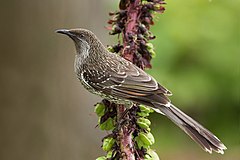Anthochaera
| Anthochaera[1] | |||
| Vigors & Horsfield, 1827[2] | |||
 Przedstawiciel rodzaju – koralicowiec kosmaty (A. chrysoptera) | |||
| Systematyka | |||
| Domena | |||
|---|---|---|---|
| Królestwo | |||
| Typ | |||
| Podtyp | |||
| Gromada | |||
| Podgromada | |||
| Infragromada | |||
| Rząd | |||
| Podrząd | |||
| Rodzina | |||
| Rodzaj | Anthochaera | ||
| Typ nomenklatoryczny | |||
Certhia mellivora Latham, 1801 = Merops chrysopterus Latham, 1801 | |||
| Synonimy | |||
| Gatunki | |||
| |||
Anthochaera – rodzaj ptaka z rodziny miodojadów (Meliphagidae).
Zasięg występowania
Rodzaj obejmuje gatunki występujące w Australii i na Tasmanii[7].
Morfologia
Długość ciała 20–50 cm; masa ciała 27–260 g (samce są nieco większe i cięższe od samic)[8].
Systematyka
Etymologia
- Anthochaera (Acanthochaera): gr. ανθος anthos – kwiat; χαιρω khairō – cieszyć się[9].
- Anellobia: gr. negatywny przedrostek αν- an-; ελλοβιον ellobion – kolczyk, od λοβος lobos – małżowina uszna[10]. Gatunek typowy: Certhia mellivora Latham, 1801 = Merops chrysopterus Latham, 1801.
- Coleia: Charles Frederick Cole (1875–1959), australijski urzędnik państwowy, ogrodnik i kolekcjoner[11]. Gatunek typowy: Merops carunculatus Shaw, 1790.
- Dyottornis: Robert Dyott (rok 1913), australijski ornitolog i kolekcjoner; Gr. ορνις ornis, ορνιθος ornithos – ptak[12]. Gatunek typowy: Corvus paradoxus Daudin, 1800.
- Colena: jak Coleia[13]. Nowa nazwa dla Coleia.
Podział systematyczny
Do rodzaju należą następujące gatunki[14]:
- Anthochaera chrysoptera – koralicowiec kosmaty
- Anthochaera lunulata – koralicowiec mały
- Anthochaera phrygia – koralicowiec królewski
- Anthochaera carunculata – koralicowiec czerwony
- Anthochaera paradoxa – koralicowiec żółty
Przypisy
- ↑ Anthochaera, [w:] Integrated Taxonomic Information System [online] (ang.).
- ↑ N.A. Vigors & T. Horsfield. Description of the Australian Birds in the Collection of the Linnean Society; with at Attempt at arranging them according to their natural Affinities. „Transactions of the Linnean Society of London”. 15 (1), s. 320, 1827. (ang.).
- ↑ J. Cabanis: Museum Heineanum: Verzeichniss der ornithologischen Sammlung des Oberamtmann Ferdinand Heine, auf Gut St. Burchard vor Halberstadt. Cz. 1: Singvögel. Halberstadt: In Commission bei R. Frantz, 1850–1851, s. 120. (niem.).
- ↑ H.F. Gadow: Catalogue of the Birds in the British Museum. Cz. 9: Perching birds. London: 1884, s. 262. (ang.).
- ↑ a b G.M. Mathews. New generic names for Australian birds. „Austral Avian Record”. 1, s. 116, 1912–13. (ang.).
- ↑ G.M. Mathews. Forwarded the descriptions of a new subspecies. „Bulletin of the British Ornithologists’ Club”. 52, s. 25, 1934. (ang.).
- ↑ F. Gill, D. Donsker & P. Rasmussen (red.): IOC World Bird List (v11.2). [dostęp 2021-12-21]. (ang.).
- ↑ P. Higgins, L. Christidis & H. Ford: Family Meliphagidae (Honeyeaters). W: J. del Hoyo, A. Elliott & D.A. Christie: Handbook of the Birds of the World. Cz. 13: Penduline-tits to Shrikes. Barcelona: Lynx Edicions, 2008, s. 620–624. ISBN 84-96553-45-0. (ang.).
- ↑ Jobling 2021 ↓, s. Anthochaera.
- ↑ Jobling 2021 ↓, s. Anellobia.
- ↑ Jobling 2021 ↓, s. Coleia.
- ↑ Jobling 2021 ↓, s. Dyottornis.
- ↑ Jobling 2021 ↓, s. Colena.
- ↑ Nazwy polskie za: P. Mielczarek & M. Kuziemko: Rodzina: Meliphagidae Vigors, 1825 - miodojady - Honeyeaters (wersja: 2021-06-27). [w:] Kompletna lista ptaków świata [on-line]. Instytut Nauk o Środowisku Uniwersytetu Jagiellońskiego. [dostęp 2021-12-21].
Bibliografia
- J.A. Jobling (red.): The Key to Scientific Names. [w:] Birds of the World (red. S.M. Billerman et al.) [on-line]. Cornell Lab of Ornithology, Ithaca, 2021. (ang.).
Media użyte na tej stronie
Autor: (of code) -xfi-, Licencja: CC BY-SA 3.0
The Wikispecies logo created by Zephram Stark based on a concept design by Jeremykemp.
Autor: JJ Harrison (https://www.jjharrison.com.au/), Licencja: CC BY-SA 3.0
Little Wattlebird (Anthochaera chrysoptera), Austin's Ferry, Tasmania, Australia

